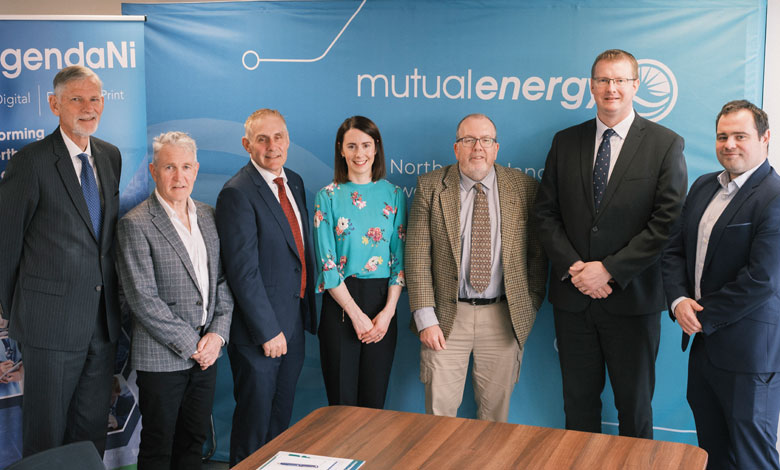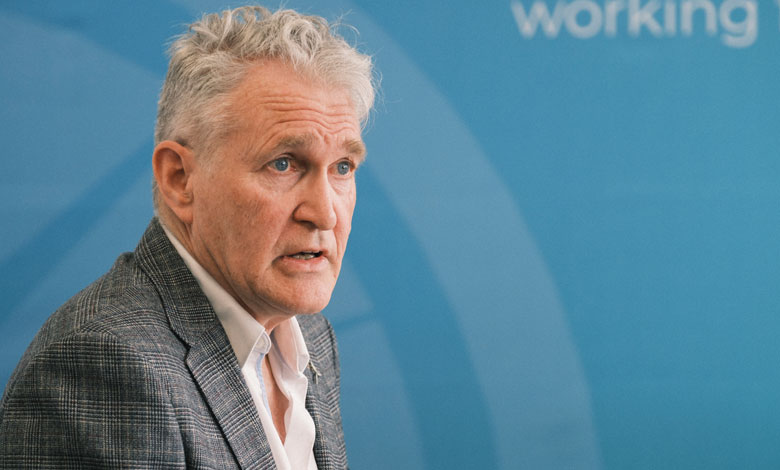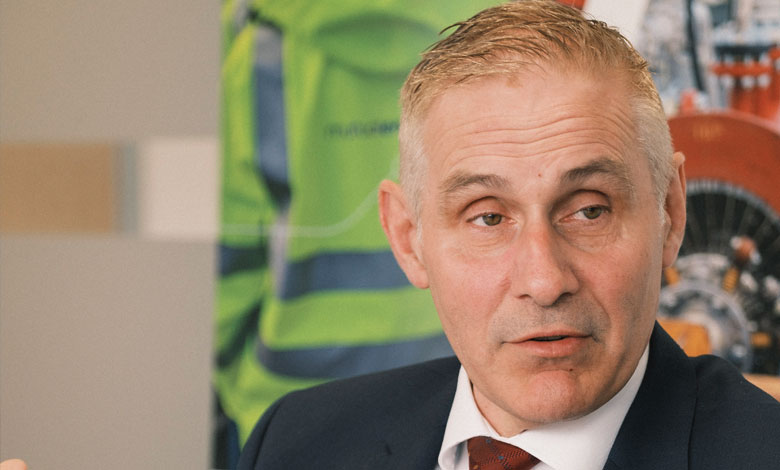The role of long-duration storage in a net zero future

Mutual Energy hosted a round table discussion with experts from across the industry to discuss the role energy storage can play in decarbonisaing Northern Ireland’s energy system.
How does long-duration storage have a role in delivering an integrated, decarbonised energy system for Northern Ireland?
Eimear Watson
Long-duration energy storage is a fundamental part of decarbonising the power system and has various benefits. One obvious benefit is the potential for SONI, as Transmission System Operator, to reduce the dispatch down of renewable generation in times of high supply, while also minimising the use of fossil-fuelled peaking plants in times of low supply, particularly over prolonged periods, which will reduce costs and help with delivering a net zero carbon energy system. Another potential benefit is assisting with grid congestion and the challenges that come with the east-west imbalance of supply and demand that we have on the power system. Ultimately, if long-duration energy storage can be deployed quicker than grid investment, then it could enable the use of more renewable generation sooner and defer or potentially remove the need for some grid investment.
Paddy Larkin
Wind and solar are the leading technologies for decarbonising our electricity network but the supply given by these technologies is not only intermittent, but also unpredictable. Ultimately, this leads to a mismatch between supply and demand. Modelling suggests that over the course of a year, with same levels of generation, and the same levels of demand, the mismatch is around 40 per cent. This is where the need for storage comes in. The benefits of increased wind generation are starting to be diminished because of the marginal cost of curtailment across the board. Developers are no longer going to absorb the risk factors of dispatch down and curtailment, so society and government will be required to take on that risk to enable the build out of the renewables needed.
David Surplus
Long-duration storage enables the management of intermittent renewables by providing instantaneous balancing of electrical load. A typical curtailment episode in Northern Ireland could last for 10 hours, which exceeds the capacity of conventional batteries being operated today.
Sean Kelly
For the past 25 years flexibility in the electricity grid has been afforded by generation from natural gas stations. Now, the reality is that climate change and low carbon targets mean that we need a new approach. The island of Ireland, as an islanded electricity network, albeit with some interconnection, is at the cutting edge of incorporating high levels of renewables and the means to tackle that lie in having flexible options including a mix of short-term, medium-term, and long-term storage options.
Tony Roulstone
The future electricity system is going to be driven by supply rather than demand because of the level of variation on a grid fuelled by solar and wind generation. Our modelling for Great Britain indicated that in such a system, if you built renewable supply on a nominal basis, you would have a shortfall some 20 per cent of the time. If 20 per cent of your energy is mistimed or mismatched then you have a security of supply issue, and that is where energy storage comes in. Our research highlighted the requirement and importance of energy storage for different time periods. To move energy through time, the question is: How long does it need to be stored? We found most of the energy needed to be stored for days rather than hours, with 12 per cent only a few hours and balance for months or longer.
“A good mix of short and long-term energy storage options offers the greatest potential to maximise the renewable generation we have coming onto the system.”
Eimear Watson
Peter Russell
I think it is important to note that the overarching aim is to decarbonise across power, heat, and transport – not just to decarbonise the energy sector. Northern Ireland has a lot of advantages, because of its size and agility while also already moving at pace across many different sectors to meet ambitious decarbonisation targets. We can get the right people in a room to discuss these challenges more easily that other jurisdictions. Long-duration storage is key to addressing the intermittent and predictability challenges of renewable supply, while providing other system benefits, but it ultimately needs to delivered at a fair price for consumers and the technology options used need to be right for Northern Ireland.
Outline the long-duration storage options available that could suitably be deployed in Northern Ireland
David Surplus
The conclusion we came to with the Ballylumford Power-to-X project is that you can use the natural gas pipe network as a store. Gas infrastructure possesses five times the energy carrying capacity that the electricity grid has. Additionally, our research indicates the salt caverns at Islandmagee will be suitable for hydrogen gas storage. That would give us an almost infinite ability to put electrolyser load on to the grid and balance both wind and solar variation. Only around one-quarter of the fossil fuels consumed in Northern Ireland are for the electricity sector, as the majority are used to fuel both heat and transport. It must be recognised that as we increase renewable electricity generation, predominantly through offshore wind, not all of it will be used in the electricity sector. Consequently, there is a real opportunity to address heat and transport emissions through various e-Fuels.
“It must be recognised that as we increase renewable electricity generation, predominantly through offshore wind, not all of it will be used in the electricity sector.”
David Surplus
Sean Kelly
Northern Ireland’s electricity system is heavily dependent on fossil fuels for periods of low renewables. Therefore, storage considerations must prioritise decarbonisation. There are several options and technologies available but hydro pumped storage has been around longest and represents the most mature option, at the greatest scale to date. Hydrogen also presents great potential to ‘load shift’ renewable power. Looking beyond security of supply, energy storage presents a huge economic opportunity. The industrial revolution was built on the availability of cheap fuel. Ireland has the best renewables resource in western Europe and therefore the opportunity to capitalise on the growing demand for clean energy, not just through export, but through building the manufacturing and processes aligned with clean energy storage.
Tony Roulstone
The options available can be categorised into three types of solution. The first is short-term, for a few hours – battery systems. The second are physical-based systems which are useful in the short-to-medium term up to a week and include the likes of pumped hydro, compressed air and liquid air energy storage. Finally, chemical-based systems such as hydrogen, ammonia and synthetic fuels cover longer storage timeframes beyond a week. Cost is important. Battery systems are cheap in terms of power capacity, but expensive when you consider energy volumes. Physical-systems are between two and three times more expensive in terms of power but could be 10 times cheaper in terms of volume. Chemical systems are even more expensive when compared to batteries for providing power but can be vastly cheaper in terms of storing volume of energy. Governments need to support the demonstration of both physical and chemical storage systems, bringing them to the stage where they become replicable with supply chains that will bring down costs. While the initial cost estimates are high, replication can have a big effect as it has with wind turbines.
Paddy Larkin
I believe all the options will be needed when you consider the scale of the storage requirement, which is around one month of energy. A completely decarbonised electrical network is likely to need some 600 GWh of storage. For context, Turlough Hill Power Station, the only pumped storage in Ireland, offers around 3 GWh, giving a sense of the scale needed. We need short-, medium- and long-term options and these options have three drivers: cost; turnaround efficiency; and scale. The reality is that no option will provide all three and that is why it is important that there is a holistic approach. If we are focused on 2030 targets then batteries, with a 15-to-20-year lifespan, are the best option for quick and fast deployment but if we are decarbonising our future, then we need to be thinking longer-term about what options will pay back over 100 years, rather than 20. In making those decisions, we need to have consideration for what works best in Northern Ireland’s geology and geography, and what delivers the right value for customers.
“An evident flightpath for energy storage volume for the near, medium and long-term is key to energising progress in this area.”
Paddy Larkin
Eimear Watson
As a Transmission System Operator we would like to see a diversity of energy storage options connected to the power system. A good mix of short- and long-term energy storage options offers the greatest potential to maximise the renewable generation we have coming on to the system.
Would Northern Ireland’s energy system benefit from selecting and supporting a single long-duration storage technology?
Peter Russell
Fundamentally, the technology requirements of long-duration energy storage in Northern Ireland will be defined by the parameters of what we, as a region, are trying to achieve. All options are on the table, but 2030 is not that far away and we need to consider what is best for the long-term, as well as realising the economic opportunity that exists. It is important to define what we need from the technology, and then let the market bring forward solutions.
“Energy storage must be available to meet gaps in supply when needed, not run to maximise revenue.”
Tony Roulstone
Tony Roulstone
If the focus is on the short-term 2030 targets, then the solution will be driven by what is available and doable today, which will be battery systems plus carbon emitting gas turbines. Northern Ireland potentially will need between 200 to 300 GWh each year to balance supply and demand, while meeting its 2030 renewables target. Capital cost of batteries is estimated to be £10 billion per 100 GWh. This £20 to £30 billion is not feasible and it will not deliver net zero because of the continuing use of fossil fuel. The UK, as a whole, needs a strategy for energy storage beyond near-term targets and for the demonstration of longer term physical and chemical systems.
David Surplus
The deployment of windfarms in Northern Ireland effectively stopped in 2018 with the end of Renewable Obligation Certificates and the rise of curtailment and constraint. That undermined investor confidence to build and that is a problem when you consider the targets for 2030 and beyond. Having that long-duration controllable electrical load, in whatever form that takes, is important as a basis for increasing generation.
Paddy Larkin
The scale of the storage required is so large that there needs to be a multitude of technological solutions coming forward, and it will require most of them. However, it is worth noting that long-term storage projects in Northern Ireland would be transformational in scale. With projects that size, comes an element of risk.
What are the existing barriers to the delivery of long-duration energy storage options?
Tony Roulstone
Market-based approaches that depend on subsidies needs to be rethought because the risks to security of supply are much too high. Long-duration storage needs are strategic. Energy storage must be available to meet gaps in supply when needed, not run to maximise revenue. With market base methods, either stores could be empty when needed, or for the longest durations they will never be built.
Sean Kelly
The biggest barrier is the lack of investment signals for long duration energy storage. Currently, the drivers to develop storage are not great enough and whilst there is a recognition that while more operational storage on the grid will drive down peak costs for the consumer, the arbitrage for the developer will be lower. The question is how do we finance it in the longer term if there is no incentive for developers and manufacturers?
“The biggest barrier is the lack of investment signals for long-duration energy storage.”
Sean Kelly
Eimear Watson
I agree, the main barrier to the delivery of long-duration energy storage is the missing money gap that comes from the existing market mechanisms. There is a renewables support scheme being developed by the Department for the Economy, should there equally be an energy storage support scheme developed to support these renewables connecting to the electricity system? Existing market mechanisms should be reviewed and new market mechanisms explored as well. SONI and EirGrid published a Call for Evidence on Long Duration Energy Storage in 2023 and are currently finalising our response.
Paddy Larkin
In current market mechanisms, security of supply provision through storage is not rewarded. Not only is the arbitrage ability very low, but there is no certainty around what the grid will require. If you consider these projects being long-life, what is the incentive for a developer to assume risk on what is going to happen in 40 or 50 years’ time? The introduction of interconnectors in Great Britain is a good exemplar of how other mechanisms were deployed in recognition that the market would not function if such high risk remained. The underpinning of risk by things like a cap and floor regime should be explored.
Identify one priority policy lever required to ensure that long-duration storage delivers a balanced and cost-efficient energy system?
Sean Kelly
The speed of the planning system is creating real challenges in delivering new infrastructure at the speed of change we need to meet decarbonisation targets. The planning system must be properly resourced, and planning polices aligned with climate policy.
Tony Roulstone
You cannot design long-term energy storage systems using one-year models of weather and demand. Current models are adaptions of power matching models. If we want to ensure security of supply for the long-term, we need to match long-term weather data (decadal) with long-term solutions.
Peter Russell
A good starting point is defining what type of a system we require and then fully assessing how that would operate. For example, how much risk does the government and the consumer take on these projects, and does there need to be a capacity requirement that is set aside as strategic reserve, rather than allowing them to fully arbitrage in the market, to ensure security of supply? A study of deployment of long-duration storage in other small countries could provide some insight.
“It is important to define what we need from the technology, and then let the market bring forward solutions.”
Peter Russell
Eimear Watson
If we can get the right people together in a room from across the industry and come up with a strategic spatial energy plan for Northern Ireland, which sets out what we need, the volumes required and suitable locations then I think we would have a strong basis to deliver a balanced and cost-efficient energy system.
David Surplus
My ideal policy lever would be to have some consideration of private wires and how they would be facilitated to enable a hydrogen network. If you now accept that the lifespan of an offshore wind turbine is 35 years and that the electrolysers are 35 years, then there is no such thing as an electricity price because you are not trading on any markets. We have a 35-year certainty on what our energy input costs will be, and that resource could be retrospectively available to the electricity market at a fraction of the cost of in-market conditions with legislative and system changes.
Paddy Larkin
A secure revenue stream is critical. Where risk is transferred to customers to ensure a secure revenue stream, it needs to be managed in a way that maximises the value attained, under normal circumstances, from a project that did not have that security. Additionally, as can be seen by the 80 per cent renewable consumption target for 2030, targets work to drive progress. An evident flightpath for energy storage volume for the near, medium and long-term is key to energising progress in this area.













